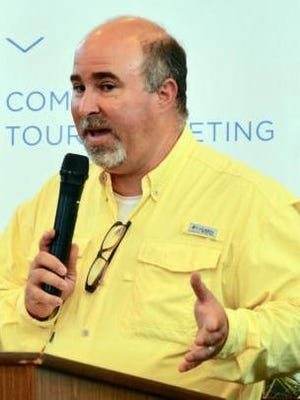
In May, collections of the countywide 2 percent lodging tax fell by more than $42,000, from a little over $166,000 last year, to about $124,000 two months ago, a drop-off of 25 percent.
Put in context, this was very good news.
In addition to being a much higher collection number than originally estimated, the numbers shared by Tourist Development Council Director John Solomon to the county commission Tuesday morning showed that occupancy levels for the county for the first seven months of calendar year 2020 are outpacing both the Northwest Florida region as well as the entire state, by as much as 25 percent.
So much so, he said, it appears the county will finish the fiscal year at the end of September, at or above last year’s record tally of $1.4 million in lodging tax revenue.
“We should match or surpass that,” said Solomon, noting that the county is only down about $103,000 in year to date totals, and that May numbers apply to just one dozen days in which short-term rentals were allowed by the state to operate. “With us showing a slight increase or a match (for the rest of the fiscal year) that means collections for the county will be similar to last year, if not a little bit more
“We were over 25 percent higher in percentage over (all of) northwest Florida,” he said. “These are amazing numbers for the county as it comes to collections and taxes.”
At last week’s budget workshop, Solomon presented a budget for fiscal year 2020-21 that showed a proposed 2.5 percent decrease, from about $1.76 million to 1.72 million.
He said that the decrease was made possible by reducing the budgeted amounts for repaying debt, which the TDC administers for land acquisitions made by the county in years past.
“With the uncertainty with COVID-19 stuff, it would be safe to not add that back in the budget,” Solomon said.
The proposed budget does not factor in a proposed increase from 2 to 3 percent in the lodging tax, which is now on the table before the county commission. If the commissioners vote to approve the increase by a super-majority, of at least four yes votes, then the higher tax amount would not take effect until the first day of the second month after passage.
Solomon said that when the TDC resumed advertising, “we didn’t focus on anything but our wide open spaces. We did minimalist advertising but letting people know there is a place to go to get away from large crowds.”
At the budget workshop, Erin Griffith, the county’s assistant finance director, shared details of 2017 study by Visit Florida on the impact of travel and tourism to the Florida economy.
The study showed Franklin County ranked second in the state, with 62 percent of employment being supported by tourism.
“The tourism industry in Franklin County results in property management businesses, cleaning services, yard maintenance, construction, fishing charters, dining, and spending in local shops and groceries,” she read. “This economic activity contributes directly to Franklin County’s share calculation for state shared sales tax revenues, gas tax proceeds and health care trust fund tax dollars.
“To put the market in perspective, the state estimated Franklin County was going to have over $70 million in taxable transient rentals this prior state fiscal year – for the third least populated county in Florida with a population just over 11,000 people, counties with similar taxable sales include much larger counties such as Flagler, Indian River, Marion, Martin, Pasco and Santa Rosa,” said Griffith. “We need to bring attention to the fact that the tourism industry does have a positive impact on the county budget.”




